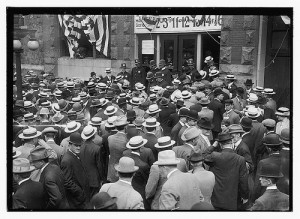Category: Research
Summary: 3 Features in Successful Cultural Heritage Outreach Events

The following reflections summarize features of cultural heritage outreach and engagement events I have attended during my recent fieldwork at the Smithsonian Institution. I have selected three overlapping features that appear to have contributed to the success of these cultural heritage events; in an upcoming post, I will also offer several tips for improving upon these outreach strategies.
Crowdsourcing
[Gathering or requestion information and action from the crowd, audience, or user]These engagement events have been predominately in line with a citizen-scientist model or crowdsourcing model. In other words, they have gathered participation on an avocational and/or volunteer basis. They have also operated in systematic ways to collect, refine, populate, and assign values – “doing things” with materials. The events have not necessarily been science-focused, though some have been. Most have required participants to BYOD and register for participation. Several of the events have also gathered experiential information and viewpoints from participants at the close of the event.
Participatory
[Audiences or individuals “opting in” toward a goal, either personal or collective]These outreach events have been based around the idea of a shared experience of working toward a project goal – calling upon a sense of participatory culture or being creator-consumers. That means that participants have been taking actions (“doing”) toward both individual projects and shared roles or group work toward parts of a goal, whilethe event has taken participants toward achieving a collective goal in the end.
Free but exclusive
[No charge but cost of time and some bounding on event]Each of these events were held by cultural heritage institutions and were free to attend; yet, the events were also managed in a way that was bounded in number, space, or access. Clarifying my use of “exclusive” to mean selective in this context, the events have typically accepted the first candidates for participation and allowed those individuals to feel as though they are gaining unique access in some way.
The three features discussed above appear to have subtly informed approaches and agenda; and resulted in events that appeared to be reasonably successful.* Enthusiastic and engaged participants were found at all events and activities taken toward each event’s stated goals.
Despite the appearances of success for these events, each event offered several points at which engagement or efficiency could be improved. Watch this space for an upcoming post that speaks to four ways best practice at cultural heritage outreach events can be built.
*This assumption made without knowledge of each event’s stated metrics for success.
**Image of crowds outside the entrance of the 1912 Republican National Convention held at the Chicago Coliseum, Chicago, Illinois, June 18-22, 1912 – shared from George Grantham Bain Collection (Library of Congress) – via Flickr Commons
The Digital Public Library of America (DPLA)
Linking past to present, and considering the revolutionary framing of knowledge and visions for the future across space and time, Robert Darnton discusses next week’s launch of the Digital Public Library of America. This post links to one of my favorite tumblr presences, exploreblog, and their summary of Darnton’s perspectives.
I’m enthralled by the process and particularly interested in the shifts of institutional (and academic) thinking that will be required to make DPLA a success. As I also applied to be a ACLS Public fellow for DPLA, I am closely tracking developments and partnerships, such as the recent announcement the UVA libraries and the Bioheritage Diversity Library are teaming up with DPLA.
DPLA launches on April 18 and more information can be found here.
CFP: Digital Anthropology (DANG) at AAA 2013

A last minute nudge toward a call for paper abstracts on the overlap of online and physical IRL ethnographic practices for researching “digital publics.” Seeking insight into methods & ethics for a panel session at AAA 2013, the Digital Anthropology Group wants YOU for this year’s American Anthropological Association meeting in – submit an abstract TODAY 10 April for review. There are still a few hours left to join the conversation!
Call for Papers: “Digital Anthropologists’ Current Engagements with 21st Century Publics” – #Digital Publics, #Ethics, #Methods, #Insights
The panel organizers are particularly interested in exploring major questions such as:
- How do anthropologists collect and analyze data while doing digital field work?
- What are the ethical issues facing anthropologists who rely on visual data and texts collected in the digital publics of the internet (social networking sites, forums, websites, etc)?
- How does digital anthropology intersect with the physical as people increasingly act in physical space in response to the digital realm?
- What kind of “future publics” are being constructed through today’s “current engagements” by users and anthropologists in the cyberspatial plazas of the internet (social networking sites, etc.)?
These questions can be explored in the panel through “ethnographic examples and evidence of the interactions between digital/online and physical life” – while linking the future of anthropological engagements with the public to current concerns about digital studies in anthropology.
Click through for more information and good luck!
US Holocaust Museum & crowdsourcing displaced children identities

Today is Yom HaShoah or Holocaust Remembrance Day, part of the Days of Remembrance 07-14 April.
You can help the US Holocaust Memorial Museum further identify displaced children of the Holocaust. This is a remarkable project that calls upon the power of crowdsourcing and (re)defining lost pasts through shared memory.
Here are details for the Remember Me? project:
If you recognize yourself or someone you know in one of the photos, please contact the Museum’s Holocaust Survivors and Victims Resource Center at RememberMe@ushmm.org or via phone at 202-488-0416.
The most recently updated profile of Fischer Kampel suggests that memories of these experiences offer comfort to families, too. Kampel’s example underscores the ways in which understanding the experiences of these children helps wider understanding of the role of the Holocaust experience in adult life; and also the ways survivors communicated or were unable to communicate the horrors to their families.
More images and names here and further details about the Remember Me? Project available here – and see @HolocaustMuseum Twitter feed for events and to learn more.
Day of DH (#dayofdh)

I’m excited to be participating in #dayofdh today- which I admittedly stumbled upon last night – and to learn so much more about DH activities around the world. There are already some fascinating insights into the range of interests, activities, behaviors, and of course humor of DH practitioners at work today.
Follow this project on Twitter using #dayofdh or @DayofDH and at the host site at MSU with a collaborative focus – Day of DH 2013
Here’s the description from Twitter: “A Day in the Life of the Digital Humanities is a project that examines the state of the digital humanities through the lens of those within it.”
Also follow my tweets updating my DH work today or have a gander at my #dayofdh site
meghaninmotion for #dayofdh
More to follow in a write up of the experience today –
**note the site title is meghaninmotion, as one might anticipate, though my internal handle came out meghaninotion (meghan in otion… meghan in OCEAN??)

